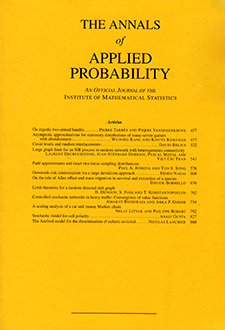Abstract
The state of the self-organizing cluster process is a finite subset of points in a bounded region. This subset represents an evolving discrete approximation to a continuous probability distribution in the region. The dynamics of the process is determined by an independent sequence of random points in the region chosen according to the distribution. At each time step the random point attracts the nearest point in the finite set. In this way the subset learns to approximate its environment. It is shown that initial states approach each other exponentially fast for all time with probability one. Thus all memory of the initial state is lost; the environment alone determines future history.
Citation
Robert M. Burton. William G. Faris. "A self-organizing cluster process." Ann. Appl. Probab. 6 (4) 1232 - 1247, November 1996. https://doi.org/10.1214/aoap/1035463330
Information





